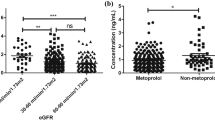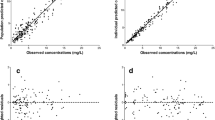Abstract
Purpose
This study evaluated the population pharmacokinetics of daptomycin in nonobese elderly patients with hypoalbuminemia and chronic kidney disease (CKD) using the glomerular filtration rate estimated from cystatin C (eGFRcys) and estimated its optimal dose.
Methods
We performed population pharmacokinetic analysis of the unbound concentrations of daptomycin. The probability of target attainment of 90% for achieving an area under the concentration–time curve of unbound daptomycin at steady state/ minimum inhibitory concentration ratio of ≥66.6 was stochastically simulated.
Results
In the population pharmacokinetic analysis of 25 patients aged ≥65 years, the two-compartment model using eGFRcys and age as covariates of clearance in central compartment of unbound daptomycin were optimal. The unbound fraction rate (fu) was 0.05–0.14. According to the Monte Carlo simulation, the optimal doses for patients with eGFRcys of 20–60 mL/min and aged 65–95 years were calculated as 200–500 mg q24h.
Conclusion
These results suggest that establishing the dose using total concentrations may result in under- or overestimation caused by alterations in fu. The optimal dose for nonobese elderly patients with hypoalbuminemia and CKD depends on eGFRcys and age, and a standard dose may be insufficient for some patients.






Similar content being viewed by others
References
Safdar N, Andes D, Craig WA. In vivo pharmacodynamic activity of daptomycin. Antimicrob Agents Chemother. 2004;48(1):63–8.
Falcone M, Russo A, Cassetta MI, Lappa A, Tritapepe L, d'Ettorre G, et al. Variability of pharmacokinetic parameters in patients receiving different dosages of daptomycin: is therapeutic drug monitoring necessary? J Infect Chemother. 2013;19(4):732–9.
Bhavnani SM, Ambrose PG, Hammel JP, Rubino CM, Drusano GL. Evaluation of daptomycin exposure and efficacy and safety endpoints to support risk-versus-benefit considerations. Antimicrob Agents Chemother. 2015;60(3):1600–7.
Matsumoto T, Takesue Y, Iwata S, Ueda T, Uchiyama K, Kobayashi K, et al. Practical guidelines for the management and treatment of infections caused by MRSA, 2019 edition. Tokyo, Japan: Japanese Society of Chemotherapy/ Tokyo, Japan: the Japanese Association for Infectious Diseases; 2019. http://www.chemotherapy.or.jp/guideline/guideline_mrsa_2019.pdf. Accessed 14 October 2020, Japanese.
Liu C, Bayer A, Cosgrove SE, Daum RS, Fridkin SK, Gorwitz RJ, et al. Clinical practice guidelines by the Infectious Diseases Society of America for the treatment of methicillin-resistant Staphylococcus aureus infections in adults and children. Clin Infect Dis. 2011;52(3):e18–55.
Bhavnani SM, Rubino CM, Ambrose PG, Drusano GL. Daptomycin exposure and the probability of elevations in the creatine phosphokinase level: data from a randomized trial of patients with bacteremia and endocarditis. Clin Infect Dis. 2010;50(12):1568–74.
Dvorchik B, Arbeit RD, Chung J, Liu S, Knebel W, Kastrissios H. Population pharmacokinetics of daptomycin. Antimicrob Agents Chemother. 2004;48(8):2799–807.
Cojutti PG, Candoni A, Ramos-Martin V, Lazzarotto D, Zannier ME, Fanin R, et al. Population pharmacokinetics and dosing considerations for the use of daptomycin in adult patients with hematological malignancies. J Antimicrob Chemother. 2017;72(8):2342–50.
Chaves RL, Chakraborty A, Benziger D, Tannenbaum S. Clinical and pharmacokinetic considerations for the use of daptomycin in patients with Staphylococcus aureus bacteraemia and severe renal impairment. J Antimicrob Chemother. 2014;69(1):200–10.
Grégoire N, Marchand S, Ferrandière M, Lasocki S, Seguin P, Vourc'h M, et al. Population pharmacokinetics of daptomycin in critically ill patients with various degrees of renal impairment. J Antimicrob Chemother. 2019;74(1):117–25.
Dvorchik BH, Damphousse D. The pharmacokinetics of daptomycin in moderately obese, morbidly obese, and matched nonobese subjects. J Clin Pharmacol. 2005;45(1):48–56.
Chin PKL, Florkowski CM, Begg EJ. The performances of the Cockcroft-Gault, modification of diet in renal disease study and chronic kidney disease epidemiology collaboration equations in predicting gentamicin clearance. Ann Clin Biochem. 2013;50(6):546–57.
Dowling TC, Wang ES, Ferrucci L, Sorkin JD. Glomerular filtration rate equations overestimate creatinine clearance in older individuals enrolled in the Baltimore longitudinal study on aging: impact on renal drug dosing. Pharmacotherapy. 2013;33(9):912–21.
Fliser D, Ritz E. Serum cystatin C concentration as a marker of renal dysfunction in the elderly. Am J Kidney Dis. 2001;37(1):79–83.
Amano H, Yoshimura K, Iijima R, Waki K, Matsumoto K, Ueda H, et al. A slight decrease in the serum albumin level is associated with the rapid progression of kidney dysfunction, even within the normal range. Intern Med. 2020;59(21):2679–85.
Chang TJ, Zheng CM, Wu MY, Chen TT, Wu YC, Wu YL, et al. Relationship between body mass index and renal function deterioration among the Taiwanese chronic kidney disease population. Sci Rep. 2018;8(1):6908. https://doi.org/10.1038/s41598-018-24757-6.
Cockcroft DW, Gault MH. Prediction of creatinine clearance from serum creatinine. Nephron. 1976;16(1):31–41.
Matsuo S, Imai E, Horio M, Yasuda Y, Tomita K, Nitta K, et al. Revised equations for estimated GFR from serum creatinine in Japan. Am J Kidney Dis. 2009;53(6):982–92.
Horio M, Imai E, Yasuda Y, Watanabe T, Matsuo S. Collaborators developing the Japanese equation for estimated GFR. GFR estimation using standardised serum cystatin C in Japan. Am J Kidney Dis. 2013;61(2):197–203.
Dubois D, Dubois EF. A formula to estimate the approximate surface area if height and weight be known. 1916. Nutrition. 1989;5(5):303–11.
Yano R, Nakamura T, Tsukamoto H, Igarashi T, Goto N, Wakiya Y, et al. Variability in teicoplanin protein binding and its prediction using serum albumin concentrations. Ther Drug Monit. 2007;29(4):399–403.
Enokiya T, Muraki Y, Iwamoto T, Okuda M. Changes in the pharmacokinetics of teicoplanin in patients with hyperglycaemic hypoalbuminaemia: impact of albumin glycosylation on the binding of teicoplanin to albumin. Int J Antimicrob Agents. 2015;46(2):164–8.
Di Paolo A, Tascini C, Polillo M, Gemignani G, Nielsen EI, Bocci G, et al. Population pharmacokinetics of daptomycin in patients affected by severe gram-positive infections. Int J Antimicrob Agents. 2013;42(3):250–5.
Chen YC, Feng JF, Li B, Zhang L, Yang YW. Estimation of safe and effective dose of vancomycin in MRSA-infected patients using serum cystatin C concentrations. Int J Clin Pharmacol Ther. 2013;51(3):161–9.
Tanaka A, Aiba T, Otsuka T, Suemaru K, Nishimiya T, Inoue T, et al. Population pharmacokinetic analysis of vancomycin using serum cystatin C as a marker of renal function. Antimicrob Agents Chemother. 2010;54(2):778–82.
Okamoto G, Sakamoto T, Kimura M, Ukishima Y, Sonoda A, Mori N, et al. Serum cystatin C as a better marker of vancomycin clearance than serum creatinine in elderly patients. Clin Biochem. 2007;40(7):485–90.
Tanaka A, Suemaru K, Otsuka T, Ido K, Nishimiya T, Sakai I, et al. Estimation of the initial dose setting of vancomycin therapy with use of cystatin C as a new marker of renal function. Ther Drug Monit. 2007;29(2):261–4.
Kasai H, Tsuji Y, Hiraki Y, Tsuruyama M, To H, Yamamoto Y. Population pharmacokinetics of teicoplanin in hospitalized elderly patients using cystatin C as an indicator of renal function. J Infect Chemother. 2018;24(4):284–91.
Hermida J, Tutor JC. Serum cystatin C for the prediction of glomerular filtration rate with regard to the dose adjustment of amikacin, gentamicin, tobramycin, and vancomycin. Ther Drug Monit. 2006;28(3):326–31.
Otsuka T, Tanaka A, Suemaru K, Inoue T, Nishimiya T, Murase M, et al. Evaluation of the clinical application of cystatin C, a new marker of the glomerular filtration rate, for the initial dose-setting of arbekacin. J Clin Pharm Ther. 2008;33(3):227–35.
Tan SJ, Cockcroft M, Page-Sharp M, Arendts G, Davis TME, Moore BR, et al. Population pharmacokinetic study of ceftriaxone in elderly patients, using cystatin C-based estimates of renal function to account for frailty. Antimicrob Agents Chemother. 2020;64(10):e00874–20. https://doi.org/10.1128/AAC.00874-20.
Dvorchik B, Damphousse D. Single-dose pharmacokinetics of daptomycin in young and geriatric volunteers. J Clin Pharmacol. 2004;44(6):612–20.
Moise PA, Amodio-Groton M, Rashid M, Lamp KC, Hoffman-Roberts HL, Sakoulas G, et al. Multicenter evaluation of the clinical outcomes of daptomycin with and without concomitant β-lactams in patients with Staphylococcus aureus bacteremia and mild to moderate renal impairment. Antimicrob Agents Chemother. 2013;57(3):1192–200.
Falcone M, Russo A, Venditti M, Novelli A, Pai MP. Considerations for higher doses of daptomycin in critically ill patients with methicillin-resistant Staphylococcus aureus bacteremia. Clin Infect Dis. 2013;57(11):1568–76.
Kullar R, Casapao AM, Davis SL, Levine DP, Zhao JJ, Crank CW, et al. A multicentre evaluation of the effectiveness and safety of high-dose daptomycin for the treatment of infective endocarditis. J Antimicrob Chemother. 2013;68(12):2921–6.
Crompton JA, North DS, McConnell SA, Lamp KC. Safety and efficacy of daptomycin in the treatment of osteomyelitis: results from the CORE registry. J Chemother. 2009;21(4):414–20.
Seaton RA, Menichetti F, Dalekos G, Beiras-Fernandez A, Nacinovich F, Pathan R, et al. Evaluation of effectiveness and safety of high dose daptomycin: results from patients included in the European Cubicin outcomes registry and experience. Adv Ther. 2015;32(12):1192–205.
Kato H, Hagihara M, Nishiyama N, Koizumi Y, Yamagishi Y, Matsuura K, et al. Clinical effectiveness of daptomycin loading dose in patients infected with gram-positive pathogens. J Infect Chemother. 2017;23(3):161–4.
Kato H, Hagihara M, Shibata Y, Asai N, Koizumi Y, Watarai M, et al. Retrospective study on clinical efficacy and safety for daptomycin intermittent doses with or without loading dose in renal failure patients. J Infect Chemother. 2020;26(3):215–24.
Bowker KE, Noel AR, MacGowan AP. Comparative antibacterial effects of daptomycin, vancomycin and teicoplanin studied in an in vitro pharmacokinetic model of infection. J Antimicrob Chemother. 2009;64(5):1044–51.
Author information
Authors and Affiliations
Corresponding author
Additional information
Publisher’s Note
Springer Nature remains neutral with regard to jurisdictional claims in published maps and institutional affiliations.
Supplementary Information
ESM 1
(DOCX 69 kb)
Acknowledgments and Disclosures
We would like to thank Enago (www.enago.jp) for the English language review. Masaru Samura, Risako Yamamoto, Yuki Enoki, Kazuaki Taguchi, and Kazuaki Matsumoto contributed to the study conception and design. Material preparation and data collection were performed by Masaru Samura, Keisuke Takada, Risako Yamamoto, Hayato Ito, Fumio Nagumo, Masaki Uchida, Takenori Kurata, Sakura Koshioka, Yuki Enoki, Ryuji Higashita, Norifumi Kunika, and Koji Tanikawa. Analysis and interpretation of data were performed by Masaru Samura, Keisuke Takada, Risako Yamamoto, Hayato Ito, Yuki Enoki, Kazuaki Taguchi, Koji Tanikawa, and Kazuaki Matsumoto. The first draft of the manuscript was written by Masaru Samura and all authors commented on previous versions of the manuscript. All authors read and approved the final manuscript. This study received no funding. The datasets generated or analysed during the current study are available from the corresponding author on reasonable request. None to declare.
Rights and permissions
About this article
Cite this article
Samura, M., Takada, K., Yamamoto, R. et al. Population Pharmacokinetic Analysis and Dosing Optimization Based on Unbound Daptomycin Concentration and Cystatin C in Nonobese Elderly Patients with Hypoalbuminemia and Chronic Kidney Disease. Pharm Res 38, 1041–1055 (2021). https://doi.org/10.1007/s11095-021-03058-0
Received:
Accepted:
Published:
Issue Date:
DOI: https://doi.org/10.1007/s11095-021-03058-0




